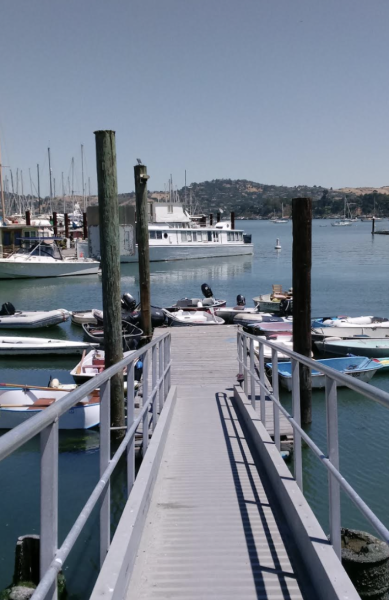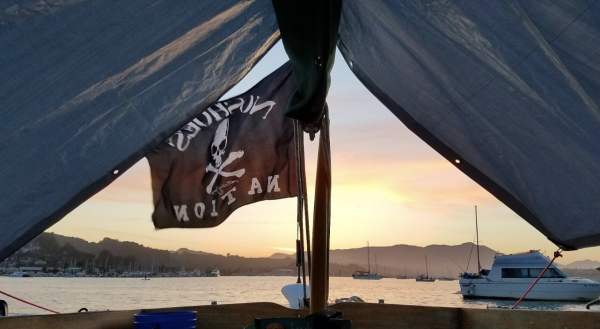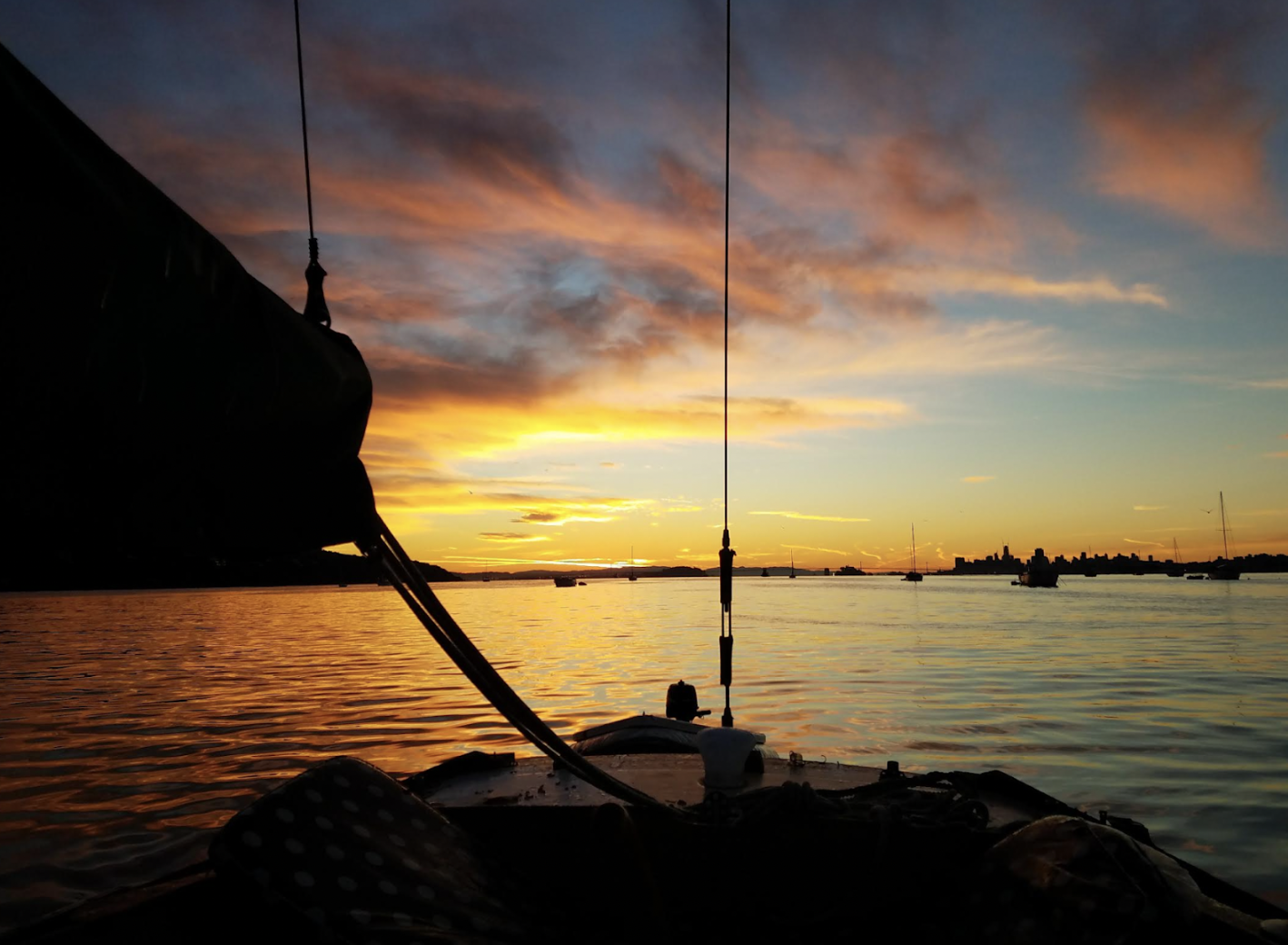Patrick O’Brien has been living on Richardson Bay for 11 years. According to him, being an anchor out is represented in three words: the American dream.
“Watching life go by as container ships and oil tankers pass in front of San Francisco, the greatest Christmases ever, watching the boat parade, surviving the storm’s chaos and often sleeping through them,” O’Brien listed, reminiscing on his life as an anchor out.
“Seeing the beauty of nature through birds, seals, and little stingrays, the joy of seeing people visit the water with amazement and smiles, and of course the greatest reward is helping other people in a predicament, and even saving a life or two,” O’Brien continued.
On any given Sunday morning, sailboats, motorboats, and other vessels set out on Richardson Bay for scenic pursuits and to take advantage of Marin’s pleasantly predictable weather. Staying out on the water all day doesn’t sound too bad, neither does living on the Bay.

Background
Located just north of San Francisco, along the Bay, lies Sausalito, Calif.
According to the Visit Sausalito website, “Sausalito is known for its luxe accommodations, acclaimed chefs at farm-to-table restaurants, and art galleries. Don’t forget about all the on-the-water experiences. Sausalito is the ideal destination for sailing and kayaking around the San Francisco Bay.”
One distinct, but often forgotten, aspect of Sausalito’s character is embodied by the “anchor outs,” a name for Sausalito residents who have decided to live on boats moored in Richardson Bay in Marin County. The anchor outs are an often criticized group because they tend to avoid property taxes. According to the Pacific Sun, the anchor outs are a criticized group, yet their dwellings remain anchored, “much to the chagrin of the authorities governing the waters.”
“As a Sausalito resident, I’ve noticed a harsh attitude toward the anchor outs, but I believe they are part of Sausalito and its history, plus they’re not exactly the most disruptive group,” Tamalpais High School senior Presley Eckhardt said.
According to KQED, a local chapter of PBS television stationed in the Bay Area, the history of the anchor out community dates back to the 1880s when rich San Francisco residents built houseboats around the bay as second homes used for vacationing. Boardwalks connected the boats to land. These houseboats used to be referred to as “arks” due to their ark-style roofs.
In 1906, an earthquake destroyed around 500 blocks of San Francisco and spread fires that lasted for three days. According to KQED, this forced many previously dual homeowners to move into their houseboats as their full-time residence.
Throughout the next 30 years, many people docked their houses or moved them onto shore.
Following World War II, living on the water was popularized when the waters surrounding Sausalito were transformed into an emergency shipyard known as Marinship. According to FoundSF, Marinship was used to fuel vessels such as America’s oil tankers and war cargo ships.
KQED also reported that Don Arques, a man who used to work for the shipyard, took leftover land and resources from Marinship and distributed them to local artists and returning soldiers. Many of these people began to build homes on the water, which varied in size, shape, and all-around appearance.
KQED also reported that in the 1950s, officials tried to move people off of the water, attributing it to the lack of sewage hookups to houses. Officials and “boaters” continued to have sprawls, legal battles, and even physical encounters until five permanent marinas were built for houseboats to dock.
According to KQED, not all boaters wanted to be docked and resorted to the anchor-out lifestyle. This rent-free lifestyle became more and more appealing, and in 2016 there were 235 anchor outs living in Richardson Bay.
Sausalito Resident Perspectives
Sausalito resident Stacy Newcomer’s journey to becoming an anchor out boat began with a sudden change of events.
“In January 2016, we lost my childhood home,” Newcomer said.
With her fiancé, they navigated the challenges of finding a place to live with their pitbull, while staying at her fiancé’s plumbing shop in Santa Rosa, Calif. While searching for an ideal living situation, a cabin cruiser captured their attention.
“We saw a rental listed on Craigslist for a 1948 Chris Craft cabin cruiser and could afford it,” Newcomer said. “It was a move of desperation, sprinkled with adventure.”
With a roof over their heads and a newly found connection to nature, Newcomer and her fiancé found peace living on a boat.

According to Tam senior Aurelia Joy—who lives on a houseboat near the anchor-out community—this luxury of a calm boat life is not so easily found.
“They [Richardson Bay Regional Agency] made anchor outs illegal because they didn’t want them in the bay. I notice that Sausalito is getting nicer and more expensive. They are not fitting the expectations,” Joy said.
Sausalito’s rising property values pose a problem for those who have been living in the continuously developing town. These long time residents have to deal with the increasing prices that come with living in Sausalito. Indicated by the real estate agency, Compass, the median price for purchasing a house in the Bay Area was a maximum of $350,000 in 1990. As of May 2024, houses around Marin are sold for an average price of $1.3 million, if not more. According to PayScale, an American compensation software and data company, the price of living in Sausalito is 97 percent higher than the national average.
“Once again it’s the rich versus the poor,” anchor out Arthur Bruce said. “The rich don’t want to look at us out here. I say if you don’t want to see any boats, maybe you shouldn’t have built your house in the middle of an anchorage.”
Joy’s father, Daren Joy, said it is hard to see the history of the anchor outs go away so fast. “I’ve lived in Sausalito for 20 years, and the anchor outs are part of the culture, but I understand where it’s [drive for anchor outs to leave is] coming from,” Joy said.
Amalie Stoker, a junior at Tam and former Sausalito resident, reflected on her elderly family friend Barbara’s life as a houseboat resident.
“Barbara lived on a houseboat until she passed away last year,” Stoker said. “She lived in Sausalito before the housing prices rose, then she was forced to move onto a houseboat because she couldn’t afford to live in her house anymore.”
Stoker’s recollection of Barbara is fond, but she remembers the struggles Barbara Rossi had to face regarding housing prices in her hometown of Sausalito.
Some Sausalito residents find it unacceptable to kick someone out of their home or leave them with no place to go.
“When I was told we were moving to a houseboat in Sausalito, I honestly had no idea of the whole controversy surrounding anchor outs. I was living in Mill Valley, in my own bubble,” Tam senior and Sausalito resident Sarah Collins said. “Once we moved here at the beginning of this year, it has become apparent that the challenges anchor outs are facing are very real, and we as residents need to be more aware. They are equally part of the community as anybody else.”
Some anchor outs are not pleased with being asked to leave.
“I’m not moving out of here, they’d have to drag me out in handcuffs. I’ve been to jail, I’m not scared. Especially because we aren’t doing anything wrong,” Bruce said.
This eviction poses a problem. The unwillingness to leave coupled with the fact that eviction could result in homelessness makes the move less appealing for everyone.

The RBRA and BCDC’s efforts
“Once off the water, where do these people go? You are essentially taking away someone’s ‘homeless encampment’ on the water, and forcing them to be homeless on land,” Adam Schermerhorn, public information officer of the Marin Sheriff’s Department, said. “The need for community programs, focused on housing and job placement are crucial.”
The Richardson Bay Regional Agency’s (RBRA) goal is to prevent homelessness from happening through its programs. The RBRA is a local government agency that serves the waters of Tiburon and unincorporated Southern Marin County. It has the authority to manage and evict anchor outs who are living in the Bay.
Separate from the RBRA, the Bay Conservation and Development Committee (BCDC) is a state agency that oversees and manages the San Francisco Bay development and preservation. The BCDC and the RBRA constructed a mission statement, as the BCDC felt that the RBRA was not properly enforcing the laws regarding the anchor outs.
As seen in the mission statement, “[The] RBRA will provide quarterly reports to BCDC to include non-confidential information received from outreach agencies, organizations and local entities that RBRA is collaborating with…”
With similar concerns, the City of Sausalito felt that it should hand over enforcement to the Sausalito Police Department. Negotiations between the RBRA and the BCDC began right before 2019, and they developed a timeline with a final goal.
Will Reisman, an RBRA media publicist, said that as of September 2021, “[The RBRA] is under a mandate from the State of California to establish and maintain a 72-hour anchorage while simultaneously preserving and promoting the substantial eelgrass bed that is located within Richardson Bay.”
By October 2023, floating homes had been removed from the anchorage. The agreement stated that, by October 2024, all 2019 and earlier vessels were to be removed. The RBRA has requested an extension to fulfill the agreement set for October 2024.
Additionally, the RBRA has now received a $3 million grant from California to fund a housing plan. This program is intended to provide temporary housing to those evicted from the water.
Currently, according to the RRBA, they are working to move vessels to the south end of the Bay and enforce new anchorage regulations. Buoys and signages are expected to be in place by July, and the RBRA is developing new citations to remain firm on the regulations.
“Our agreement with the Bay Conservation and Development Commission started in 2019. That’s when our new efforts began, but they were also coupled with COVID so we weren’t able to do anything during Covid and we kind of started things up again in 2022,” Brad Gross, executive director of the RBRA said.
Gross started his work with the RBRA in 2023, but he has worked around the Bay Area for almost 30 years.
Before being a director at the RBRA, Gross was the harbormaster for the City of Berkeley in 1996, “That’s when I first became familiar with Richardson Bay because my good friend and colleague, Bill Price, was the harbormaster in Richardson Bay dealing with the anchor outs,” Gross said.
He mentioned the numerous programs that the RBRA has installed to ensure a smoother transition for anchor outs, from sea life to a “new living situation.”
The Vessel BuyBack Program and the Housing Voucher Program are two of the programs mentioned by Gross. The former is intended to help anchor outs to make some money off of their boats when they sell and the latter entails temporary housing until the evicted can get “whatever they need so that their new existence and new housing is successful,” Gross said.
Reisman explained their vessel acquisition program, which gives financial compensation to anchor-out individuals, irrespective of vessel condition.
“We purchase vessels from anchor-out individuals, regardless of condition, at a rate of $150 a linear foot,” Reisman said.
According to Reisman, this initiative not only provides financial relief to residents but also facilitates the removal of unused vessels, contributing to the overall environmental sustainability of Richardson Bay.
Closing
Like many Sausalito residents, Eckhardt observed that the community is divided upon their various opinions regarding the RBRA and BCDC’s decisions,
“While I personally think these BuyBack programs are a good solution, I think people need to be more sensitive around the matter. People kind of have the attitude of ‘problem solved’, but they should put themselves in the position of the anchor outs. Imagine how hard it must be to be asked to leave your home and forced to adjust to a new and completely different way of living,” Eckhardt said.

To that extent, anchor out O’Brien is not satisfied with the RBRA and BCDC’s new programs.
“The local establishment of bureaucrats has an agenda that includes removing my community and our freedoms by using duress, pressure, intimidation and lawfare to accomplish their goal,” O’Brien said.
Stephan Ehert has been a part of the anchor out community since 1950, and has noticed the dramatic shift they are experiencing.
“There once was 200 thriving vessels. Now there is around 30. With all the evictions going on, next year there will most likely be gone entirely,” Ehert said.
“I often say that the anchor out community is the last refuge of low income, and it is unfortunate because it was a place where people living on the edge could go and not have to be homeless. I don’t know what I am going to do,” Ehret said on his journey as an anchor out.








